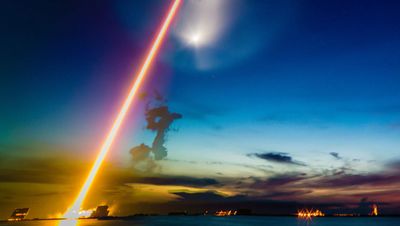NASA Has the Technology to Save Us From an Asteroid Strike, But Congress Won’t Fund It
At the biannual Planetary Defense Conference earlier this year, NASA ran a simulation of an asteroid slamming into the center of Manhattan.
For several millennia now, we've been lucky, but our luck won't hold out forever.
The gathering of astronomers, planetary scientists, and FEMA disaster-response experts attempted a number of interventions that might be possible within a time window of eight years, the given warning period before impact.
Catastrophic asteroid crashes are not without precedent, and scientists say it's only a matter of time before another one occurs—that is, if we do nothing to prevent it. It's believed that a huge asteroid crash off the coast of Mexico's Yucatan Peninsula created a worldwide disaster that helped to speed the extinction of the dinosaurs 65 million years ago.
In 1908, a meteoroid less than 300 feet in diameter exploded in the air over the Tunguska region of Siberia, creating a shockwave that leveled trees for hundreds of square miles. It's a matter of sheer luck it didn't hit a major population center, where human casualties could have been enormous.
For several millennia now, we've been lucky, but our luck won't hold out forever. There are millions of asteroids circulating about in our solar system, some of them hundreds of miles across, and although the odds of a massive one crashing to Earth in the near future is statistically low, the devastation could be apocalyptic.
Back at the conference, the experts tried sending several spacecrafts to knock the asteroid off-course by slamming into it. They considered blasting it with nuclear weapons. They even considered painting it white so it absorbed less of the sun's energy, hoping that would shift the asteroid's trajectory. In the simulations, all of the interventions failed and the giant space rock crashed into Manhattan, killing 1.3 million people in a massive explosion that was 1,000 times more powerful than the Hiroshima bomb.
NEOCam is designed, tested, and ready to build, but the project is currently frozen because of a $40 million gap in NASA funding.
Given more time, the scientists said, they might have succeeded in preventing the disaster. However, with today's asteroid-hunting telescopes, it's not likely we would have more warning. Our current telescopes are not powerful enough to detect all the near-earth asteroids, nor are they positioned well enough for sufficient detection. As recently as last week, for example, an asteroid traveling 15 miles a second narrowly missed crashing into the Earth, and it was only noticed several days in advance.
Now for the good news: There is a new technology that could buy us the time we need, says MIT planetary sciences professor Richard P. Binzel and colleagues who attended the conference. The Near-Earth Object Camera, or NEOCam, designed by NASA's Jet Propulsion Laboratory, would detect more than 90 percent of nearby objects that are 420 feet across or larger, according to Binzel.
The powerful infrared telescope is designed to sit within the L1 Lagrange point, a stable location in space where the gravitational pulls of the Earth and the sun cancel each other out. From there, large space bodies could be detected early enough to give scientists decades of warning when an asteroid is heading for Earth. NEOCam is designed, tested, and ready to build, but the project is currently frozen because of a $40 million gap in NASA funding.
The status of NEOCam, according to Binzel, is a case-study in short-sightedness and a lack of leadership. Congress needs to raise NASA's Planetary Defense budget from its current $160 million to $200 million to get the telescope built and launched into space, a goal that would seem eminently doable within the strictures of 2020's $4.75 trillion government budget. But Binzel describes a current deadlock between NASA, Congress, and the Office of Management and Budget as a "cosmic game of chicken."
If we don't use our technology to defend the planet, "it would be the most epic failure in the history of science."
In an excruciatingly budget-conscious atmosphere, "No one wants to stick their neck out and take adult responsibility" for getting the funding allocated that would unfreeze the project, says Binzel. But, he adds, "We have a moral obligation to act."
NEOCam would not only spot the overwhelming majority of asteroids in Earth's vicinity, it would determine their size and pinpoint exactly where they are likely to strike the Earth. And it would allow us decades to act, according to Binzel. Repeated ramming by an international armada of specialized spacecraft could slightly change the trajectory of an asteroid, he says. Changing the trajectory only a tiny bit, given the scale of millions of miles and several decades for the course change to take effect, could cause an asteroid to miss the Earth altogether.
"So far we've been relying on luck," says Binzel, "but luck is not a plan." Now that we have the technology to discover what's careening through our space neighborhood, it's our ethical duty to deploy it. If we don't use our technology to gain the knowledge we need to defend the planet, Binzel concludes, "it would be the most epic failure in the history of science."
